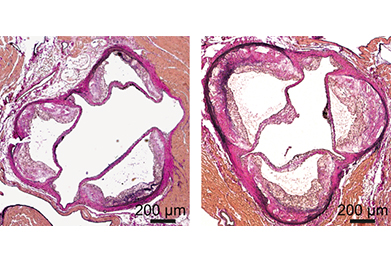The enzyme Dicer cleaves long precursors into short RNA molecules called microRNAs. A new study by IPEK scientists reveals how Dicer enhances energy metabolism and reduces levels of fat storage in macrophages, thus slowing the progression of atherosclerosis.
Atherosclerosis is one of the primary causes of premature death in modern societies. The condition is characterized by the deposition of fat-soluble molecules – principally cholesterol and triglycerides – on the inner walls of major blood vessels. This process triggers vascular inflammation and the formation of atherosclerotic plaques, which ultimately lead to narrowing of the arteries, thus impeding the flow of blood. Cells called macrophages are responsible for the uptake and disposal of the fatty deposits that induce plaque formation. However, depending on how they have been activated, macrophages can play an insidious role in the development of atherosclerosis. Inflammatory activation promotes inflammation, while ‘alternatively activated’ macrophages suppress inflammation reactions. The latter degrade triglycerides by means of fatty acid oxidation, but if this pathway operates suboptimally – due to local inflammation, for example – they accumulate the engulfed fats, thus contributing to plaque development and increasing the risk of blood vessel blockage. A team of researchers in the Institute for Cardiovascular Prevention, led by Professor Andreas Schober, has now shown that the enzyme Dicer plays an important role in the breakdown of triglycerides in alternatively activated macrophages. The findings appear in the latest issue of the journal Circulation.
Further reading
Ein Schnitt gegen zu viel Fett
Das Enzym Dicer steigert durch die Bildung kurzer RNA Moleküle den Energiestoffwechsel in Zellen des Immunsystems. LMU-Forscher zeigen, wie es dazu beiträgt, die Fettspeicherung in diesen Zellen zu vermindern und so ihr Überleben zu verbessern.
Atherosklerose gehört weltweit zu den häufigsten Todesursachen. Die Krankheit entsteht durch Ablagerungen von Fetten – vor allem Cholesterin und Triglyzeride – in den Gefäßinnenwänden, die zur Bildung atherosklerotischer Plaques und zur Verengung der Gefäße führen. Eine wichtige Rolle im Krankheitsgeschehen spielen Makrophagen, sogenannte Fresszellen, die das abgelagerte Fett entfernen und speichern, falls sie mehr Fett aufnehmen als sie verwerten können. Im Gegensatz zu Cholesterin können Makrophagen Triglyzeride abbauen. Wird dieser Abbau gestört – etwa durch eine Entzündung – speichern die Makrophagen zu viel Fett und sterben. Dies erhöht das Risiko für einen akuten Gefäßverschluss. Ein Team um den LMU-Mediziner Professor Andreas Schober vom Institut für Prophylaxe und Epidemiologie der Kreislaufkrankheiten am Klinikum der LMU hat nun gezeigt, dass das Enzym Dicer für den Fettabbau in Makrophagen eine wichtige Rolle spielt. Ihre Ergebnisse stellen die Wissenschaftler im Fachmagazin Circulation vor.

